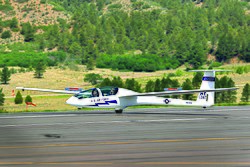| DG-1000 | |
|---|---|
 DG-1000 with 20-metre wingspan. | |
| General information | |
| Type | Two-Seater Class sailplane |
| National origin | Germany |
| Manufacturer | DG Flugzeugbau |
| History | |
| First flight | July 2000 |
The DG Flugzeugbau DG-1000 is a two-seater class glider built by DG Flugzeugbau. It first flew in July 2000 at Speyer in Germany. [1] There are four models, with 18- and 20-metre wings [1] of HQK-51 profile. The latest DG-1001 variant replaced the DG-505 in production. [2]
Contents
- Operational history
- Variants
- Operators
- Military
- Specifications (DG1000T)
- Sources
- References
- External links
With a 18 m (59 ft) wingspan, it is fully certified for aerobatics (+7 -5 g); with a 20 m (66 ft) wingspan, it is certified for limited aerobatics (+5 -2.65 g).
The engine (DG1000T) is mounted on a pylon aft of the double cockpit. There is a reduction gear (2.3:1.0) between the engine and the two-blade carbon-fibre composite propeller. The propeller was designed by and made in the DG factory.
